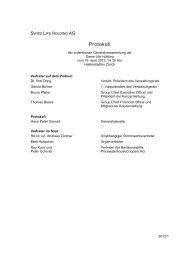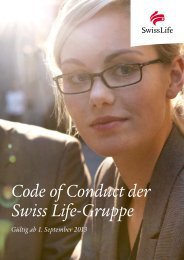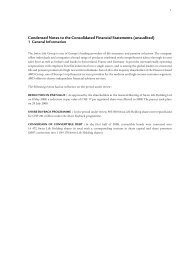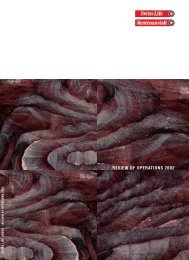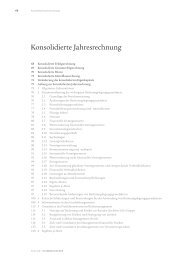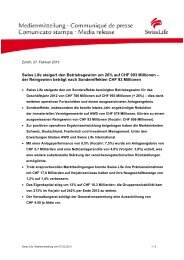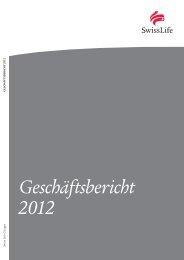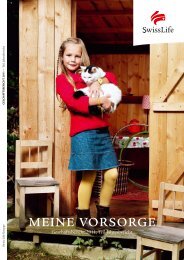Annual Report 2012 - Swiss Life
Annual Report 2012 - Swiss Life
Annual Report 2012 - Swiss Life
Create successful ePaper yourself
Turn your PDF publications into a flip-book with our unique Google optimized e-Paper software.
167 Consolidated Financial Statements<br />
and their modification. To ensure that the Group’s principles are observed, guidelines on reinsurance<br />
have been introduced.<br />
In accordance with its retention policy, for mortality and disability benefits, the Group limits its<br />
exposure to CHF 5 million per life. Retention limits can be lower for other products (e.g. critical illness<br />
or long-term care) or for exposure in international markets. In addition, catastrophe reinsurance<br />
is in place to protect against accumulation of losses from a single event or a series of connected events.<br />
The reinsurance team at Group level is responsible for implementing the retention policy by way of<br />
intra-group reinsurance. Intra-group reinsurance is transacted at arm’s length.<br />
As far as property and casualty insurance is concerned, the reinsurance arrangements mostly include<br />
non-proportional coverage on any single risk and/or event, and are adapted to the specific exposure.<br />
This includes excess of loss, stop-loss and catastrophe coverage, as well as facultative reinsurance for<br />
protection against specific risks.<br />
No single reinsurer is a material reinsurer to the Group, nor is the Group’s business substantially<br />
dependent upon one single reinsurer.<br />
Approximately 1.5% in terms of earned insurance premiums was ceded as at 31 December <strong>2012</strong> (2011:<br />
1.6%).<br />
Other risk transfer<br />
Risk transfer primarily takes the form of reinsurance. Alternative forms of risk transfer (such as securitisation)<br />
require the formal approval of the Group Risk Committee. No significant alternative form<br />
of risk transfer is used by the Group at present.<br />
Insurance risks are regularly reported to the Group Risk Committee.<br />
Sensitivity analysis<br />
The <strong>Swiss</strong> <strong>Life</strong> Group uses the market consistent embedded value (MCEV) following the guidelines<br />
of the European Insurance CFO Forum Market Consistent Embedded Value Principles ©1 , as one of<br />
the main management tools, for its sensitivity analysis with regard to insurance risk and market risk.<br />
From the shareholders’ point of view, the embedded value serves as an indicator of the value of the<br />
existing insurance portfolios. It is composed of two components: the net asset value (NAV) attributable<br />
to shareholders and the value of in-force business (VIF). Future new business is not included.<br />
The market consistent embedded value of the <strong>Swiss</strong> <strong>Life</strong> Group amounted to CHF 9.6 billion as at<br />
31 December <strong>2012</strong> (2011: CHF 7.7 billion). Due to different valuation principles, changes in the<br />
embedded value are typically not reflected to the same extent in the consolidated balance sheet and<br />
consolidated statement of income of the <strong>Swiss</strong> <strong>Life</strong> Group and vice versa.<br />
The market consistent embedded value calculations are based on economic scenarios which are calibrated<br />
to market conditions at valuation date. Best estimate assumptions were made regarding a<br />
number of factors, in particular asset allocation, policyholder participation, development of costs<br />
and claims, policyholder behaviour, mortality and morbidity. Business is assumed to be continuing<br />
1<br />
Copyright © Stichting CFO Forum Foundation 2008<br />
<strong>Swiss</strong> <strong>Life</strong> – <strong>Annual</strong> <strong>Report</strong> <strong>2012</strong>



